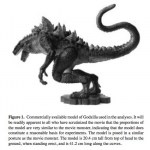tyrannosaurus
At 13 metres in length, Tyrannosaurus rex had little to fear from other predators. But it was occasionally attacked by an enemy far smaller than itself. In a wonderful piece of forensic palaeontology, Ewan Wolff from the University of Wisconsin has shown that the tyrant lizard king was often infected by a microscopic parasite, whose relatives still infect the birds of today. Potentially transmitted through bites from other tyrannosaurs, the parasite could have starved the infected animals to death.
Many of the large meat-eating dinosaurs have wounds on their heads that were clearly inflicted…
Meet Raptorex, the "king of thieves". It's a new species of dinosaur that looks, for all intents and purposes¸ like the mighty Tyrannosaurus rex, complete with large, powerful skull and tiny, comical forearms. But there's one very important difference - it's 100 times smaller. Unlike the ever-shrinking world of music players and phones, it seems that evolution crafted tyrannosaur technology with much smaller specifications before enlarging the design into the giant predators of the late Cretaceous.
Raptorex is a new species of meat-eating dinosaur, discovered in northwest China by Paul…
There is a reason why there are no dinosaur geneticists - their careers would quickly become as extinct as the 'terrible lizards' themselves. Bones may fossilise, but soft tissues and molecules like DNA do not. Outside of the fictional world of Jurassic Park, dinosaurs have left no genetic traces for eager scientists to study.
Nonetheless, that is exactly what Chris Organ and Scott Edwards from Harvard University have managed to do. And it all started with a simple riddle: which came first, the chicken or the genome?
Like almost all birds, a chicken's genome - its full complement of DNA…
tags: dinosaurs, Tarbosaurus bataar, paleontology, fossils, Tyrannosaurs rex
The newly unveiled fossil skeleton of the juvenile Tarbosaurus bataar in its protective jacket.
Discovered in 2006, a near-perfect complete skeleton of a juvenile Tarbosaurus find was made available for public viewing for the first time today by the Hayashibara Museum of Natural Science in Okayama, western Japan. This fossil was originally unearthed from a chunk of sandstone in the Gobi Desert of Mongolia by a team of Mongolian and Japanese researchers. The fossil of the young dinosaur is roughly 70 million years…
Sometimes, you find weird stuff on the internet. But sometimes you find even weirder stuff in scientific journals. To what do I refer? A paper in the Journal of Mathematical Geology back in 2000 entitled Godzilla from a Zoological Perspective, by Per Christiansen.
This was written as a critique of the "new Godzilla" movie, arguing that it is not more biologically plausible than the "old Godzilla" of 1954.
However, calculations show that his limbs and limb muscles must have been severely undersized to move his huge bulk around at even a leisurely pace, and most other biological problems with…
Happy Halloween, everyone! In searching for a somewhat frightening image (I already recently used Prestosuchus and Amphicyon), I recalled this photo of the AMNH Tyrannosaurus rex mount. Most of the photos I have of the reconstruction are of the whole head or body, but I especially like this one for far more subtle reasons; the close-up makes it appear as if the dinosaur is just beginning to open its jaws, my imagination filling in the sound of heavy breaths escaping the cavernous tooth-lined maw.
My wife merely considers it a quirk a living with a paleontologically-oriented husband; whenever I feel like my efforts are futile, I hold my hands up against my chest with two fingers extended to represent the "useless forelimbs" of Tyrannosaurus. The evolutionary narrative of how Tyrannosaurus came to have such a massive head and such small limbs is a familiar one, physical constraints determining that the development of a large, terrible head would cause a reduction in limb size. This doesn't make the relatively minuscule limbs of Tyrannosaurus and its close relatives any less puzzling,…
